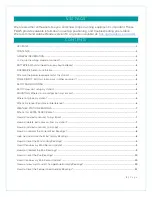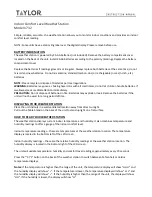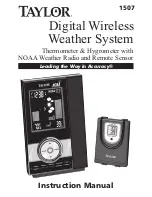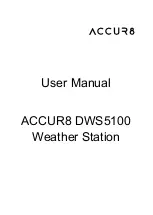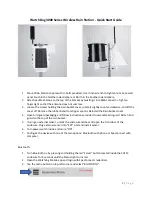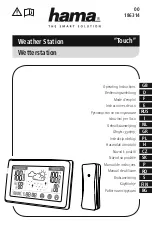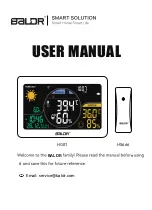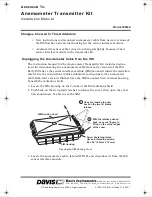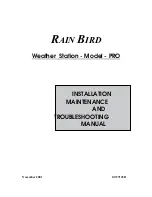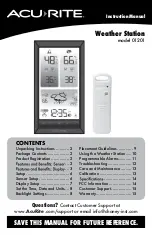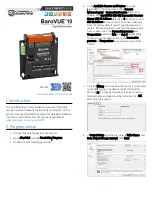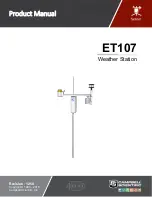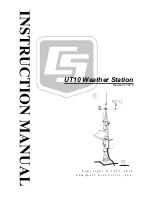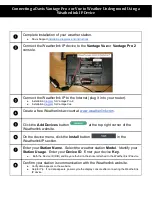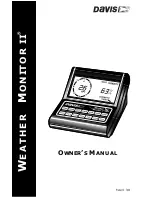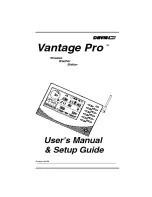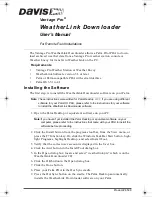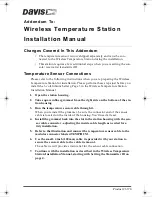
SECTION 2. WEATHER STATION INSTALLATION
2-6
Step 8
Attach the lightning rod to the 1 1/4"
sleeve on the underneath side of the crossarm.
*
Step 9
The serial (I/O) cable is mounted on
the underside of the crossarm, near the mast.
Remove the screws, insert the 9 pin D shaped
connector, and then replace the screws.
NOTE:
The cover lid is held in place by a
long bolt. Make sure that the cover plate is
in place before tightening the screws.
Step 10
Route the windset cables through
the bottom of the crossarm. Make sure the
cables pass through the grommeted slot.
*
Step 11
Observe the labeling on the sensor
leads and connect the sensor cables to the
appropriate canister cables. Arrange the
connectors so they don't interfere with the
crossarm cover. Tie down all sensor leads with
the nylon ties provided in the ends of the crossarm.
Replace the crossarm cover using the six screws.
*
Step 12
Double check the weather station to
make sure that the solar radiation and rain gage
sensors are level. Also, check to see that the
wind direction sensor is mounted on the east
side of the crossarm.
Step 13
Proper grounding of the station is
required to minimize damage from transients
caused by lightning strikes or other voltage
surges. Drive the copper plated ground rod into
the earth adjacent to the weather station and
attach the ground rod clamp. A 12 AWG green
grounding wire is connected to a ground lug on
the base. Connect the free end of the green
wire to the ground rod clamp. This important
step grounds the communications modem, the
weather station, and the CR10 datalogger.
*
Step 14
The soil temperature probe is an
optional sensor. Connections are made in the
base for ease of installation into the soil.
2.5 POWER SUPPLY INSTALLATION
2.5.1 BATTERY INSTALLATION
NOTE:
The 012 Weather Station base is at
power ground. When installing the battery
on the template inside the base, take care
not to short the positive post of the battery
to the base.
The battery may be continuously charged or
periodically exchanged with a fresh one.
Following the procedure below, batteries may
be replaced without losing power to the station.
To install a battery, locate the terminal block
inside the pedestal base where power supply
connections are made (Figures 2.5-1 and 2.5-
2). Connect the battery to the terminal labeled
"Batt 12V". The power Sonic battery supplied
by CSI is prewired with red lead positive and
black lead negative. The Power Sonic should
be continuously changed due to its smaller
capacity, 6Ahr.
Connect a user supplied battery with one of the
two power cables provided. Connect the cable
to the "BATT 12V" red positive, black negative
terminal block first then connect to the battery.
Do not connect a battery to the AUX BATT 12V
Terminal when using the PS12 charging
regulator as explained below.
Battery Replacement
The battery should be
replaced when discharged below 11 volts
(Sections 2.7, 4.6). The second set of battery
cables are provided for exchanging batteries
without interrupting power to the CR10
Datalogger. Leave the old battery connected
until the new battery is connected. Connect the
cable to the "AUX BATT 12V" terminals first,
then the circular lugs of the battery. Disconnect
and remove the old battery. Store the cable
until needed for the next battery change.
Never
leave a battery cable connected to the power
strip with the circular lugs dangling.
WARNING:
If the 12V power is
disconnected from the weather station the
data in the datalogger is lost.
2.5.2 CHARGING OPTIONS
CSI offers the PS12 12V Charger with 110
VAC to 16 VAC transformer or the MSX10R
Solar Panel for continuously charging the
battery power supply. The charging source
must be connected to the terminals labeled
"INPUT EXTERNAL CHARGING SOURCE". If
ordered with the weather station, the PS12 is
pre-mounted in the base. The MSX10R Solar
Panel is used when AC power is not available.
NOTE:
The "EXTERNAL CHARGING
SOURCE" connects only to the "BATT 12V"
terminals. The "AUX BATT 12V" terminals
are not included in the charging circuit.
Summary of Contents for 012
Page 2: ...This is a blank page...
Page 4: ...This is a blank page...
Page 6: ...This is a blank page...
Page 10: ...This is a blank page...
Page 18: ...SECTION 2 WEATHER STATION INSTALLATION 2 8 FIGURE 2 5 2 Battery AC Charging Connections...
Page 20: ...SECTION 2 WEATHER STATION INSTALLATION 2 10 FIGURE 2 6 1 RAD Modem Connections...
Page 21: ...SECTION 2 WEATHER STATION INSTALLATION 2 11 FIGURE 2 6 2 Phone Modem Connections...































